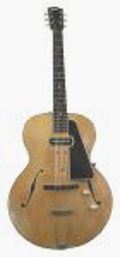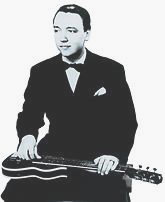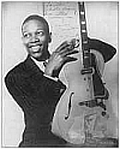Electric Guitar History
The Electric Guitar Evolves
Electric guitar history definitely began with the Frying Pan. However, many other companies picked up on the idea and Rickenbacker had a great deal of competition. Most of the electric guitars of that time were acoustics fitted with magnetic pickups.
The First "Modern" Electric Guitar...
Gibson ES 150

The electric "Spanish" style guitar was the first of the
modern style guitars produced. In 1933 LLoyd Loar, an acoustical
engineer for Gibson, created ViviTone. ViviTone was an independent
subdivision of Gibson and was dedicated to marketing the Spanish style
guitar. Unfortunately, the design of the guitar was poor and the market
was too small at the time to sustain the company, which failed within a
year. Gibson, however, was convinced that the Spanish style guitar was the future
of the instrument and once again electric guitar history was made, this
time in the form of the Gibson ES 150.
Alvino Rey

Charlie Christian

But Still There Were Problems...
Even though the ES 150 was a huge success, it had some less than ideal characteristics.
It was still a hollow bodied guitar, after all, and suffered from the same major problem
that the other electric guitars of the day did. The hollow body vibrations could be picked
up and amplified and, in addition, there were problems with feedback, distortion, and undesirable
overtones.
As a side note, the reason this occurs is that the resonant vibrations of the guitar's
body are transmitted to the pickups causing them to vibrate as well. This tends to cause secondary
currents and electric fields to be generated by the strings that essentially "clash". This "clash"
is transmitted back to the pickups causing the effects mentioned above and resulting in the ear
splitting howl we know and love(NOT) as feedback. Having your guitar start howling like a Banshee during
a cool solo tends to ruin a good tune. The next necessary step in electric guitar history was
to find a way eliminate these problems.
30 Day FREE TRIAL!








New! Comments
Have your say about what you just read! Leave me a comment in the box below.